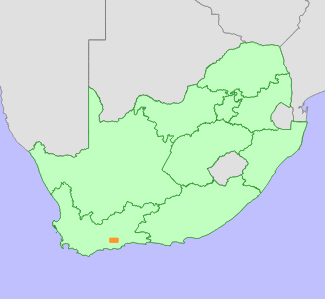|
Scientific Name | Leucospermum saxatile (Salisb. ex Knight) Rourke |
Higher Classification | Dicotyledons |
Family | PROTEACEAE |
Synonyms | Leucospermum diffusum R.Br. |
Common Names | Karoo Pincushion (e) |
National Status |
Status and Criteria | Vulnerable D2 |
Assessment Date | 2019/09/17 |
Assessor(s) | A.G. Rebelo, H. Mtshali & L. von Staden |
Justification | Leucospermum saxatile is a local endemic, with an extent of occurrence (EOO) and an area of occupancy (AOO) of 64 km². It is known from three locations which are potentially threatened by future habitat loss and degradation. It therefore qualifies for listing as Vulnerable under criterion D. |
Distribution |
Endemism | South African endemic |
Provincial distribution | Western Cape |
Range | This species is endemic to Langeberg Mountains in the Western Cape Province of South Africa, occurring from west of Garcia's Pass to Cloete's Pass. |
Habitat and Ecology |
Major system | Terrestrial |
Major habitats | Montagu Shale Renosterveld, North Langeberg Sandstone Fynbos |
Description | It grows on ecotones between arid fynbos and karoo, 250-700 m. Mature individuals are killed by fires, and only seeds survive. Seeds are released after ripening, and dispersed by ants to their underground nests, where they are protected from predation and fire. It is pollinated by birds. |
Threats |
| This species has lost 7% of its habitat to agriculture in the past and one historic subpopulation from Muiskraal is extinct. Incorrect fire management and expansion of agriculture are ongoing threats at low levels. Alien invasive ants are a potential threat as they could displace indigenous ants that disperse and bury seeds. Alien invasive plants are present at low densities, and are likely to outcompete native species if not managed. |
Population |
This species is locally abundant, forming dense stands. It is known from three subpopulations occurring over a 23 km long range on the Langeberg, each separated by 6 km gaps. The first occurs at Zandkraalsberg and consists of a small subpopulation of a few hundred plants (2001). The second is from Watervalsberg and is the largest and most extensive subpopulation consisting of several thousand plants, it is continuous over 6 km. The last subpopulation is on the Wagenboomsberg and is sparse consisting of about 100 plants over 4 kms. The population is suspected to be stable at present.
|
Population trend | Stable |
Conservation |
| It is marginally conserved with 8% of the population occurring in the Tygerberg Nature Reserve. |
Assessment History |
Taxon assessed |
Status and Criteria |
Citation/Red List version | | Leucospermum saxatile (Salisb. ex Knight) Rourke | EN B1ab(ii)+2ab(ii) | Raimondo et al. (2009) | |
Bibliography |
Goldblatt, P. and Manning, J.C. 2000. Cape Plants: A conspectus of the Cape Flora of South Africa. Strelitzia 9. National Botanical Institute, Cape Town.
Manning, J.C. and Goldblatt, P. 2012. Plants of the Greater Cape Floristic Region 1: The Core Cape Flora. Strelitzia 29. South African National Biodiversity Institute, Pretoria.
Raimondo, D., von Staden, L., Foden, W., Victor, J.E., Helme, N.A., Turner, R.C., Kamundi, D.A. and Manyama, P.A. 2009. Red List of South African Plants. Strelitzia 25. South African National Biodiversity Institute, Pretoria.
Rebelo, T. 2001. Sasol Proteas: A field guide to the proteas of southern Africa. (2nd ed.). Fernwood Press, Vlaeberg, Cape Town.
Vlok, J. and Schutte-Vlok, A.L. 2010. Plants of the Klein Karoo. Umdaus Press, Hatfield.
|
Citation |
| Rebelo, A.G., Mtshali, H. & von Staden, L. 2019. Leucospermum saxatile (Salisb. ex Knight) Rourke. National Assessment: Red List of South African Plants version 2024.1. Accessed on 2025/10/08 |
 Comment on this assessment
Comment on this assessment

